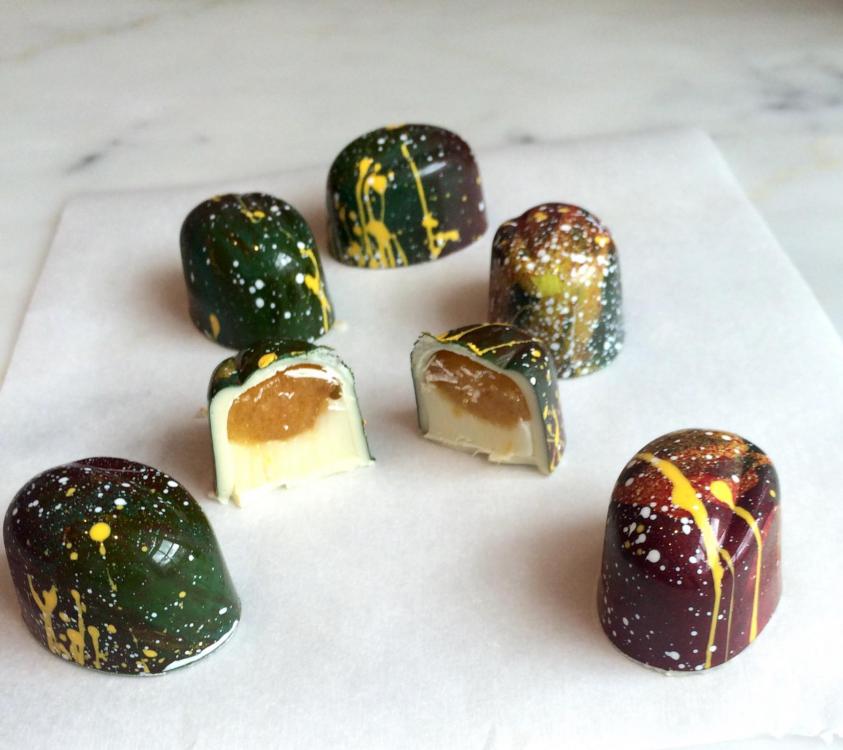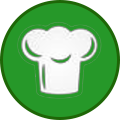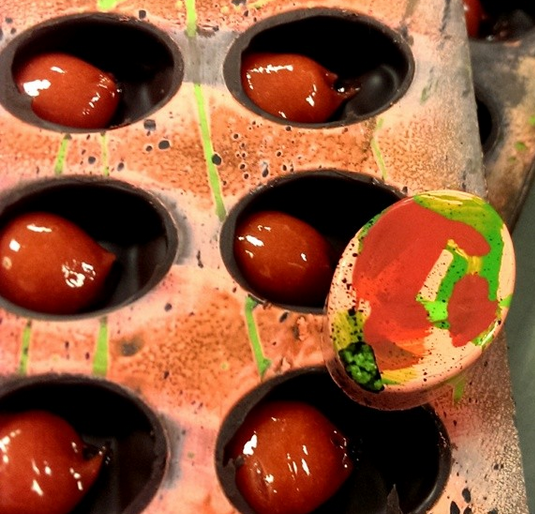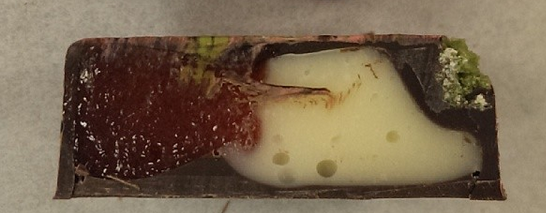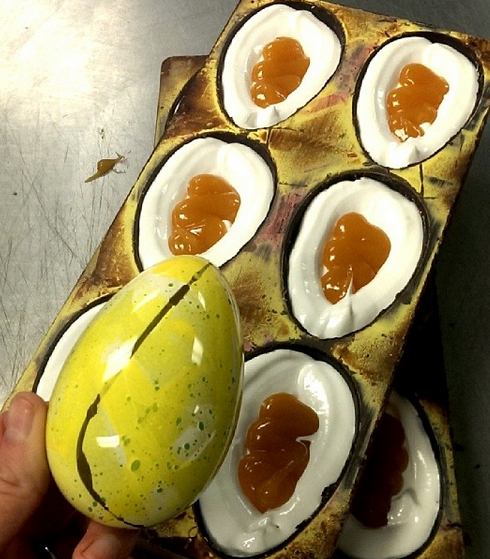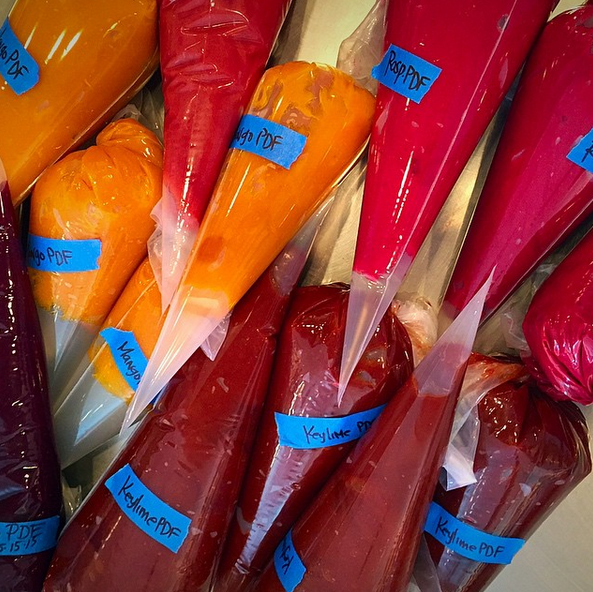
Bentley
participating member-
Posts
301 -
Joined
-
Last visited
Content Type
Profiles
Forums
Store
Help Articles
Everything posted by Bentley
-
It didn't take very much corn syrup to get to a pipeable consistency. There is so much sugar and corn syrup in the PDF to begin with. I didn't really notice any additional sweetness. I would like to experiment with using alcohol to thin it out. I could have maybe used a coconut rum in this case. The shell was done with a spatter of white cocoa butter done by running my fingers across the bristles of a toothbrush, then a splatter of yellow made by shaking a paint brush. Then a finger swirl of a light green, then airbrush half red and half darker green.
-
I experimented this weekend with blitzing the PDF in a food processor with an additional amount of corn syrup as a liquefier. I had decent success as I was able to pipe the mixture into the molded shells. I would like to thin it slightly more so that it flows into the shells and can settle flat. The problem I had was that I killed my food processor. The PDF was so thick and sticky that it caused the food processor to jam up and overheat. It was actually smoking! But anyways, behold the mango PDF with white chocolate coconut ganache with a hint of lime .
-
I hope it's ok to dredge up this old thread, but I have noticed that none of the recipes I see in the several books I have - Greweling, Shotts, Notter, etc - fit within Morato's formulas. Even the recipes from Chef Morato himself that are on the Cacao Barry site do not conform to his formulas. I am curious if people have found his calculations to be useful at all?
-
So I was doing some research, and I came across a recipe from Valrhona that called for the PDF to be piped into a bonbon. The recipe called for the PDF to be cooked and set, then put in a food processor with some Absolu Cristal, a glaze made by Valrhona. The ingredients for Absolu Cristal are listed as water, sugar, glucose syrup, pectin, carageenan and citric acid. I wonder if you could just add a little corn syrup (and maybe a little bit of water) to the PDF to get a similar same effect. You get a liquifier without adding much water and should have little effect on shelf life. (and BTW Jim, I have seen in other posts by Kate that she generally does clean the excess cocoa butter from the molds before filling them).
-
Jim - Beyond the pictures on her instagram, I haven't seen any more info about her technique. I did email her about it, but did not get a response. Here is another pic from her instagram. It's her key lime bonbon which has a key lime PDF. The piping bags are an older pic, so she has clearly changed formulas as it's no longer a red color. I was really hoping to hear from her about her technique, but she was either too busy to respond or it's a state secret. Please note that all images come from here: https://www.instagram.com/kateweiserchocolate/ As for adding puree, I don't think it would take very much to get to a pipe-able consistency. Just a small amount should be enough for the food processor to achieve a good paste. Would have to do the shelf life tests to see the effect. I suppose you could also use a small amount of alcohol to thin it, but that could probably affect the taste. https://www.instagram.com/p/BGXFpj1AtzX/?taken-by=kateweiserchocolate And here's a pic of her Strawberry Basil bonbon in the making. It's strawberry PDF and basil ganache. Interesting to see the texture of the PDF here: https://www.instagram.com/p/oYyfGigt70/?taken-by=kateweiserchocolate Vs the texture of the PDF in the finished bonbon: https://www.instagram.com/p/moWpDtgt7Y/?taken-by=kateweiserchocolate And here's a picture of a lemon PDF that looks to have a very smooth and fluid consistency: https://www.instagram.com/p/loV-Tegt1u/?taken-by=kateweiserchocolate
-
Further to the discussion of piping PDFs, I found this picture on Kate Wesier's instagram feed. From the way the PDF looks, my guess is that she is letting the PDF cool completely then perhaps blitzing it with a little more fruit puree before piping. https://www.instagram.com/p/3zGBBjAt1W/?taken-by=kateweiserchocolate
-
That's the one I'm looking at, but it's not the one I used. I referenced it to get an idea of how much puree to use and when to add it.
-
To be honest, I'm not sure. The basic caramel recipe is my own, but in Greweling's recipe for raspberry caramels, he says to add the puree when the mixture reaches 234 - so that's what I tried for the cherry puree. His recipe doesn't divide the cream in 2 parts. He adds it all in the beginning. The only thing I can think of is that adding the puree later preserves the fruit flavor and prevents it from burning from cooking too long at high temps. I may give it a try using his recipe, which is very different from mine.
-
The recipe is 400 g cream, 200g sugar, 210g glucose, 105 g butter and vanilla to that I added 200g of cherry puree (unreduced). Half of the cream is combined with the sugar, glucose and butter and melted over med-high heat while stirring until smooth. Once melted and smooth, stop stirring and cook to 244. Then add in the remaining cream, cook to 234, add puree then cook to 240. I have made the recipe before with out the puree (adding a bit more cream) and had no problems.
-
I was making a cherry caramel - similar to Grewling's raspberry caramel, but with cherry puree - and the end result was a mess. There was an enormous amount of separation between what I assume is the butter and the sugar with a large pool of oil/butterfat on top of the caramel. Its my first time making a caramel with fruit puree but I've made caramel before a million times and never seen this. I added the puree when the caramel was at 234 degrees and the puree was preheated to a little over 140 degree. The whole mixture came down to around 220 degrees and then I cooked back to 240. See the picture below. What likely happened here? Is it repairable?
-
Update: I went to a Norman Love chocolate class this evening. The white swirl is done with a finger. Apparently if you use the right pressure and speed, you will get the thin lines on each side of the finger rather than a wide brush of color. Never would've guessed. He would not divulge how they do the bonbons from the Black series.
-
Made a key lime PDF this weekend and was less than successful. I think I had the heat too high because by the time I got to 225 degrees, the mixture was dark and once it cooled it had a burnt taste and I could see little flecks of burnt sugar in the jellies. What heat do you guys use for your PDFs? I have a Wolf gas range and I am using a medium high heat. Maybe I should lower it and let the mixture cook longer? It will still reach 225* eventually right?
-
Thanks for the info. Looks like I will avoid the curds - at least until I am much more educated on shelf life issues.
-
No hurry. Thanks! How much chocolate do you use? Would a 1:1 ratio of chocolate to curd set up nicely (I'm using white chocolate for this recipe)?
-
I was going through ideas for bonbons and was thinking a bon bon using a lemon curd as a filling layer. I am curious if this would present shelf life issues. The curd would be baked until set then piped. Does anyone have any experience with this or water activity tests they've done?
-
That's not a bad idea....do those kinds of molds give the same shine as the good polycarbonate molds?
-
These are for filled bonbons, not solid pieces. And it's not urgent, just a shape I wanted for my collection. I guess I'm not crazy - it must not exist if it's this hard to find. 85g would be way too huge for a bonbon and certainly wouldn't fit in any of my packaging trays. Thanks though!
-
Smooth is strongly preferred
-
Thanks, Kerry, but that one is too thin. The shape I'm looking for is more like this - something I can use for a bonbon.
-
Nothing fancy but I can't seem to find it. I just want a round disc mold - like a hockey puck shape - that is about 14-15 grams per piece. I've checked the usual sources - chocolate world, kerekes, jbprince, etc and can't find it. Pavoni makes one that is 9gr...but that's too small for my needs. Anyone know if such a mold exists?
-
I made my coffee ganache - infusing the cream with coarsely ground dark roast beans then straining them out with cheesecloth. I do not even like coffee, but this stuff was delish!!!! Paired it with a white chocolate hazelnut gianduja, and it's one of my favorite bonbons that I've made so far.
-
Once you taken a PDF and blitz it, will it firm up again once piped or will it have a consistency like jam?
-
Blitzing? Not a term I'm familiar with. Can you tell me what that means?
-
I made a peach PDF this weekend. My two biggest issues when making PDFs are (1) sweetness. No matter what the fruit, everything just tastes like sugar to me. There is so much sugar in the recipe, that the sweetness just overpowers the flavor of the fruit. I will try mixing the acid into the sugar coating. Does it have to be citric acid or does tartaric work as well? How much of the acid do you mix in with the sugar? The second issue is the speed with which it sets. I cook to 107* and it is setting as I am pouring it out of the pan into a frame. No big deal for candies or for enrobed bonbons, but if I want to use it in a molded bonbon, there is no way I could pipe it. By the time it cooled enough to put in chocolate shells, it would be way too firm to pipe. How do people do molded bonbons with a PDF layer? I see it on different chocolatier websites all the time, so there must be a way.

